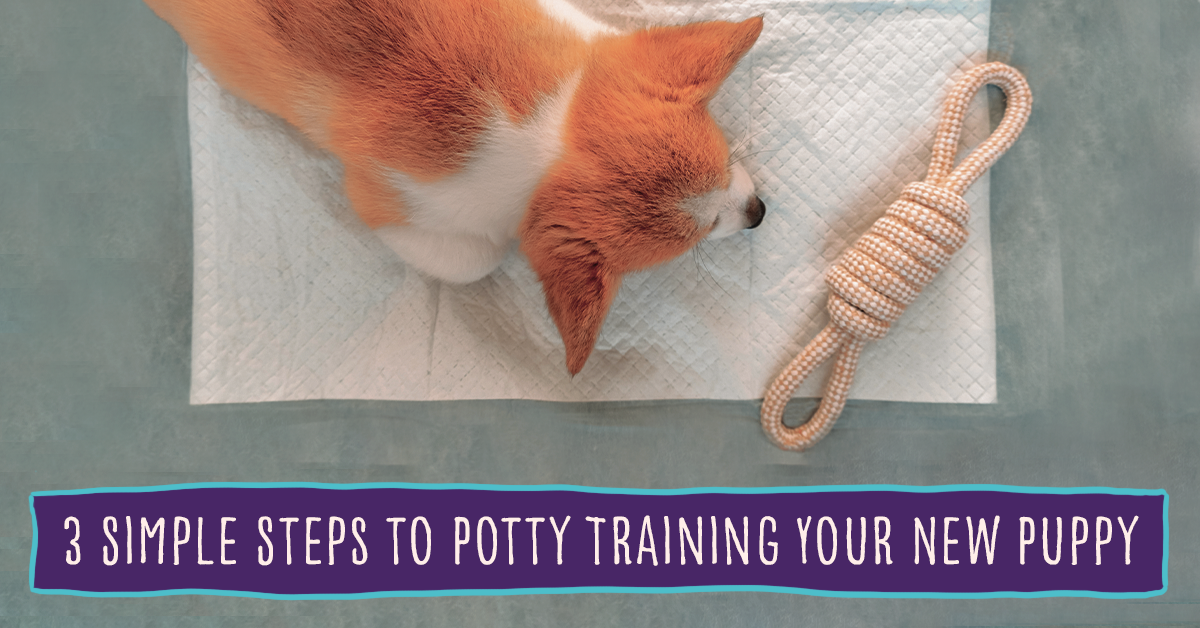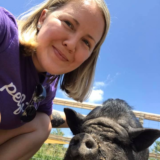
Is your pup ready to become a potty-trained graduate?
If you thought potty training humans was challenging, you may be in for a ruff surprise with a new pup! But don’t be discouraged—in fact, please be patient—because with the right steps (and a four-legged friend that’s eager to please), you’ll soon have a puppy graduating from accident-prone to potty-trained.
Step 1 (if under 16 weeks)
Start with a potty pad.
According to American Kennel Club (AKC), puppies don’t know how to control their bladders until they’re 16 weeks old, so if your pup has yet to reach this age, you’ll want to start with potty pads and monitor them closely.
Take them to their potty pad frequently—how often, according to AKC, depends on their age and bladder strength. You’ll want to monitor your puppy for the I-need-to-potty signals, which include whining, circling around, and sniffing the ground … it’s likely you’ve seen this before! If moving about your home, keep them on a leash with you so you can continue to keep a close watch. If you aren’t able to monitor them closely, or have to leave home for a bit, confine them to a comfortable crate (which we talk about in Step 3).
Step 1 (if over 16 weeks)
Teach them a potty signal.
When it’s time to take your pup out to potty, start with your pup leashed by the door that opens to their potty-haven.
Signal Option 1: Bark. You can begin by saying something like, “Ready to go potty?” Wait for them to bark… Once they bark, open the door to let them out. On that note, it’s understandable if you don’t want to teach your dog to bark every time they need to potty, so thankfully, there are other options.
Signal Option 2: Boop the bell. Begin by saying something like, “Time to go potty!?” As you say this, jingle the bell gently, and then take them out to potty. Be patient. This signal will require a lot of repetition for them to associate, “If I make this jingle, someone will let me out.”
Using your preferred signal method will teach them to associate a bark or bell-boop by the door with their need to go outside and potty. Tip: If you wind up teaching them a signal you regret, no worries! Just begin again with Step 1 using an alternative signal.
Another option includes having them sit on a designated rug or mat by the door. Depending on the layout of your home, it may be best to only use this option if their designated door is within eye reach of where you spend a lot of time in your house.
Every dog is different, so try not to get frustrated is your preferred signal option ends up not being what your new best friend prefers.
Step 2
Establish their designated potty area.
When taking them outside to potty, you’ll want to begin establishing their own designated potty area. With smells and repetition, they’ll begin to realize this established area is the place meant to do their business. Once they’ve successfully done their business, give them lots of positive praise and treats! They’ll associate this positive reward with their correct behavior and will be well on their way to potty-trained graduation.
P.S. Don’t forget to pick up that 💩!
Step 3
Use a crate when not at home!
Limiting your puppy to a comfortably confined space will limit accidents around your home when you’re not there. This can be done using a crate—their crate should be large enough for when they become full size and should allow them to comfortably stand and move around freely—or a designated room or smaller area with a tall, gated enclosure. Dogs are natural den animals so incorporating a cozy crate into your potty-training steps is very beneficial!
There are dog breeds who would rather hold it than have an accident in their confined space, but it’s not common. When you gotta go, you gotta go… Young pups just over 16 weeks old can still only hold it for a couple hours, so make sure they’re not left alone for too long or you may be cleaning up a kennel mess when you get home. If you know you’ll be gone long, limit (not deprive) water intake and treats.
Include a potty pad in their enclosed space for good measure, especially if they’re still weening off the potty pad. However, if your pup becomes destructive due to boredom by tearing up the potty pad—it happens—discontinue. Accident or not, once you arrive home, be sure to take them outside to their designated potty area right away.
(Step 4)
Having a challenge? Begin again!
Begin again at Step 1 if your puppy is having a challenging time. With a lot of patience, repetition, love and positive praise, it’s only a matter of time. If you feel like you’ve given potty-training ample time, have tried everything possible, and your pup is still having on-going challenges, reach out to you vet for help. It’s possible your pup’s on-going challenges may be medical-related, or they could be trying to tell you something.

Scheduling tips to keep in mind.
According to the American Kennel Club, “Monitor daily events and your puppy’s habits when setting up a schedule. With very young puppies, you should expect to take the puppy out:
- First thing in the morning
- Last thing at night
- After playing indoors
- After spending time in a crate
- Upon waking up from a nap
- After chewing a toy or bone
- After eating
- After drinking”
How long does it take to potty-train a puppy?
It really depends on the pup and you (yes, you too)! According to experts, there is no real, defined timeframe. Consistency and patience are key. Remember, humans and dogs are best friends, but we think and process information differently, so think about this learning process from their perspective. It takes time, but they’ll get there.
Supplies you’ll need for the journey:
- Age depending: Potty pads
- Optional: Door rug (for sitting signal)
- Optional: Bell (for bell signal)
- Urine stain remover/cleaner
- Poop bags (go earth-friendly!)
- Training treats
- Crate: A crate is an important investment. That being said, invest in one that’ll be big enough for your pup when they reach full size. Regardless, make sure it’s large enough for them to stand up and move around comfortably.
Welcome to puppy parenthood. With these proven methods (mixed with patience and consistency), your puppy will soon be on their way to potty-training graduation.
Looking for additional ways to set your new pup up for success? Protect them (and your wallet) for life from unexpected accidents or injuries. With Companion Protect® by your side, you’ll never have to settle for care you can afford over the care your pup really needs. Get a no-obligation quote today!
 SHAYNE STOREY
SHAYNE STOREY
Marketing Specialist
Shayne has a few years experience in digital marketing, content creation and animal care, with her previous role as New Media Intern at The Humane League. In her free-time she loves to cycle (with her dog on her back) and practice yoga. A social cause she cares about is climate change, the welfare of factory farmed animals, and racial equality. Her favorite food is vegan mac & cheese.

